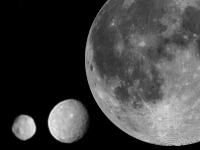Mining of Ceres

Ceres has been proposed[1][2] as one possible target for human colonization in the inner solar system.
Physical conditions
Ceres is a dwarf planet in the main asteroid belt, comprising about one third the mass of the whole belt and being the sixth largest body in the inner solar system by mass and volume. It has a round planet-like shape and a surface gravitational acceleration about 2.8% that of Earth. Observations indicate that it contains large amounts of water ice,[3][4] about 1/10 of the total water in Earth's oceans. The solar flux of 150 W/m2 (in aphelion), which is nine times smaller than that on Earth, is still high enough for solar power facilities.[1] The upcoming Juno mission to Jupiter, for example, will be relying on solar power in a location further out from the sun than Ceres.
Strategic location
Being the largest body in the asteroid belt, Ceres could become the main base and transport hub for future asteroid mining infrastructure,[1] allowing mineral resources to be transported further to Mars, the Moon and Earth.
Its colonization also could become a step on the way to the colonization of the objects in the outer solar system, such as satellites of Jupiter. Because of its small escape velocity combined with large amounts of water ice, it also could serve as a source of water, fuel and oxygen supply for ships going through and beyond the main belt.[1]
The establishment of a permanent colony on Ceres might be preceded by colonization of the Moon or Mars. As a consequence of its greater semi-major axis Ceres has more frequent launch windows to/from cislunar space than Mars, and the travel time is lower.[5] It is more energy-efficient to transport resources from the Moon or Mars to Ceres, than from Earth. In fact, transportation from Mars or the Moon to Ceres is more energy-efficient than even transportation from Earth to the Moon.[6]
Potential difficulties


- Ceres has no magnetic field.
- Ceres has no atmosphere.
- Ceres has very low surface gravity.
- Ceres receives relatively little solar radiation.
- Delta-v to/from cislunar space is rather higher than to Mars
See also
References
- ^ a b c d Template:PDFlink (Google cache)
- ^ The Ceres plan
- ^ Bjorn Carey. Largest Asteroid Might Contain More Fresh Water than Earth
- ^ P. C. Thomas et al Differentiation of the asteroid Ceres as revealed by its shape, Nature, Vol. 437, pp. 224 (2005).
- ^ [1]
- ^ Template:PDFlink
